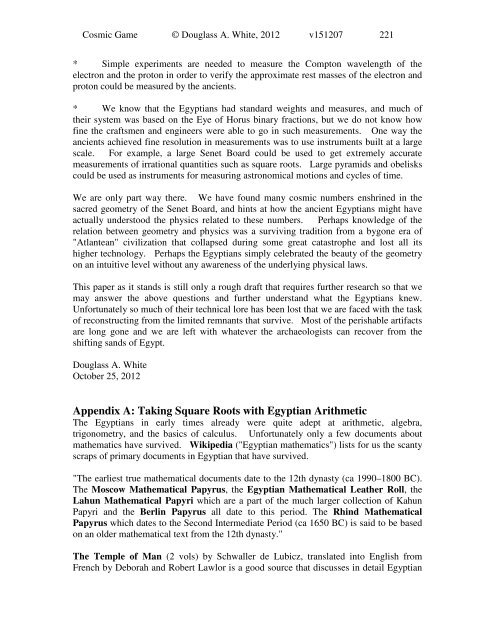You also want an ePaper? Increase the reach of your titles
YUMPU automatically turns print PDFs into web optimized ePapers that Google loves.
<strong>Cosmic</strong> <strong>Game</strong> © Douglass A. White, 2012 v151207 221<br />
* Simple experiments are needed to measure the Compton wavelength of the<br />
electron and the proton in order to verify the approximate rest masses of the electron and<br />
proton could be measured by the ancients.<br />
* We know that the Egyptians had standard weights and measures, and much of<br />
their system was based on the Eye of Horus binary fractions, but we do not know how<br />
fine the craftsmen and engineers were able to go in such measurements. One way the<br />
ancients achieved fine resolution in measurements was to use instruments built at a large<br />
scale. For example, a large Senet Board could be used to get extremely accurate<br />
measurements of irrational quantities such as square roots. Large pyramids and obelisks<br />
could be used as instruments for measuring astronomical motions and cycles of time.<br />
We are only part way there. We have found many cosmic numbers enshrined in the<br />
sacred geometry of the Senet Board, and hints at how the ancient Egyptians might have<br />
actually understood the physics related to these numbers. Perhaps knowledge of the<br />
relation between geometry and physics was a surviving tradition from a bygone era of<br />
"Atlantean" civilization that collapsed during some great catastrophe and lost all its<br />
higher technology. Perhaps the Egyptians simply celebrated the beauty of the geometry<br />
on an intuitive level without any awareness of the underlying physical laws.<br />
This paper as it stands is still only a rough draft that requires further research so that we<br />
may answer the above questions and further understand what the Egyptians knew.<br />
Unfortunately so much of their technical lore has been lost that we are faced with the task<br />
of reconstructing from the limited remnants that survive. Most of the perishable artifacts<br />
are long gone and we are left with whatever the archaeologists can recover from the<br />
shifting sands of Egypt.<br />
Douglass A. White<br />
October 25, 2012<br />
Appendix A: Taking Square Roots with Egyptian Arithmetic<br />
<strong>The</strong> Egyptians in early times already were quite adept at arithmetic, algebra,<br />
trigonometry, and the basics of calculus. Unfortunately only a few documents about<br />
mathematics have survived. Wikipedia ("Egyptian mathematics") lists for us the scanty<br />
scraps of primary documents in Egyptian that have survived.<br />
"<strong>The</strong> earliest true mathematical documents date to the 12th dynasty (ca 1990–1800 BC).<br />
<strong>The</strong> Moscow Mathematical Papyrus, the Egyptian Mathematical Leather Roll, the<br />
Lahun Mathematical Papyri which are a part of the much larger collection of Kahun<br />
Papyri and the Berlin Papyrus all date to this period. <strong>The</strong> Rhind Mathematical<br />
Papyrus which dates to the Second Intermediate Period (ca 1650 BC) is said to be based<br />
on an older mathematical text from the 12th dynasty."<br />
<strong>The</strong> Temple of Man (2 vols) by Schwaller de Lubicz, translated into English from<br />
French by Deborah and Robert Lawlor is a good source that discusses in detail Egyptian





